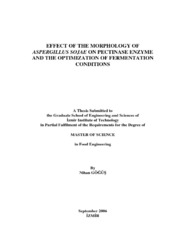Please use this identifier to cite or link to this item:
https://hdl.handle.net/11147/3862Full metadata record
| DC Field | Value | Language |
|---|---|---|
| dc.contributor.advisor | Tarı, Canan | - |
| dc.contributor.author | Göğüş, Nihan | - |
| dc.date.accessioned | 2014-07-22T13:52:31Z | - |
| dc.date.available | 2014-07-22T13:52:31Z | - |
| dc.date.issued | 2006 | - |
| dc.identifier.uri | http://hdl.handle.net/11147/3862 | - |
| dc.description | Thesis (Master)--Izmir Institute of Technology, Food Engineering, Izmir, 2006 | en_US |
| dc.description | Includes bibliographical references (leaves: 58-63) | en_US |
| dc.description | Text in English; Abstract: Turkish and English | en_US |
| dc.description | xi, 74 leaves | en_US |
| dc.description.abstract | The control of the morphology of fungi needs great attention for the optimal potential production of the product. For this purpose Aspergillus sojae ATCC 20235, which has no available literature report on the pectinase production, is used as a model in the determination of the optimum regions for maximum polygalacturonase synthesis and biomass formation with desired pellet morphology by using low cost carbon and nitrogen sources. Firstly, a full factorial statistical design, with the factors of, two taxonomically different strains, seven types of seed culture formulations (slants) and two types of fermentation media were used to investigate the effect of these parameters on the polygalacturonase (PG) production. According to statistical analysis, factors of strain types and fermentation media and the interaction between them were found significant on the enzyme activity. Aspergillus sojae in a complex media, inoculated with a seed culture prepared from molasses resulted in maximum PG activity (0.2 U/ml). Then, a two step optimization procedure with four factors (concentrations of maltrin and corn steep liquor (CSL), agitation speed and inoculation ratio) was used to investigate the effect of these parameters on the PG activity, mycelia growth (biomass) and morphology (pellet size) of Aspergillus sojae. According to the results of response surface methodology (RSM), concentrations of maltrin, CSL and agitation speed were significant (p<0.05) on both PG synthesis and biomass formation. As a result, maximum PG activity (13.5 U/ml) was achievable at high maltrin (120 g/l), low CSL (0 g/l), high agitation speed (350 rpm) and high inoculation ratio (2x107 total spore). The diameter of pellets ranged between 0.05-0.63 cm. The second optimization step improved the PG activity by 74 % and the biomass by 40 %. Furthermore characterization of the enzyme with respect to its optimum pH and temperature and the effect of these on the stability were considered. Determination of the thermal inactivation constant with its inactivation energy and the substrate specificity constant were estimated. | en_US |
| dc.language.iso | en | en_US |
| dc.publisher | Izmir Institute of Technology | en_US |
| dc.rights | info:eu-repo/semantics/openAccess | en_US |
| dc.subject.lcc | QP609.P6 G61 2006 | en |
| dc.subject.lcsh | Polygalacturonase | en |
| dc.subject.lcsh | Aspergillus | en |
| dc.subject.lcsh | Pectin | en |
| dc.subject.lcsh | Fungi--Biotechnology | en |
| dc.subject.lcsh | Fermentation | en |
| dc.title | Effect of the Morphology of Aspergillus Sojae on Pectinase Enzyme and the Optimization of Fermentation Conditions | en_US |
| dc.type | Master Thesis | en_US |
| dc.institutionauthor | Göğüş, Nihan | - |
| dc.department | Thesis (Master)--İzmir Institute of Technology, Food Engineering | en_US |
| dc.relation.publicationcategory | Tez | en_US |
| dc.identifier.wosquality | N/A | - |
| dc.identifier.scopusquality | N/A | - |
| item.openairecristype | http://purl.org/coar/resource_type/c_18cf | - |
| item.languageiso639-1 | en | - |
| item.openairetype | Master Thesis | - |
| item.grantfulltext | open | - |
| item.fulltext | With Fulltext | - |
| item.cerifentitytype | Publications | - |
| Appears in Collections: | Master Degree / Yüksek Lisans Tezleri | |
Files in This Item:
| File | Description | Size | Format | |
|---|---|---|---|---|
| T000578.pdf | MasterThesis | 1.7 MB | Adobe PDF |  View/Open |
CORE Recommender
Page view(s)
282
checked on Mar 31, 2025
Download(s)
154
checked on Mar 31, 2025
Google ScholarTM
Check
Items in GCRIS Repository are protected by copyright, with all rights reserved, unless otherwise indicated.